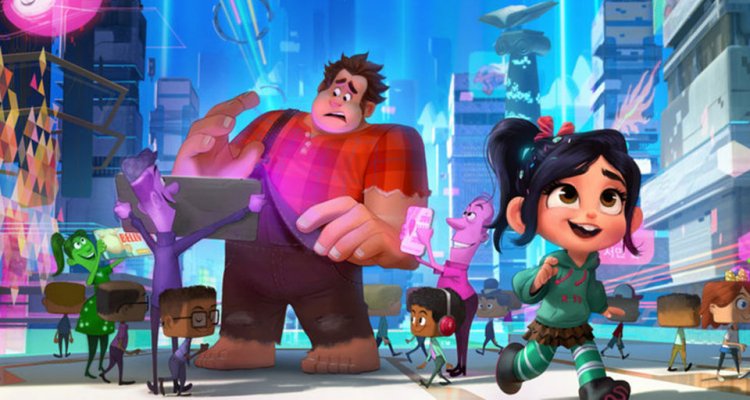At the end of 2012’s “Wreck-It Ralph,” Ralph (John C. Reilly), a brutish videogame goliath, found friendship and acceptance in the form of Vanellope (Sarah Silverman), a spritely princess from a neighboring kart racer called “Sugar Rush.” He was a character in crisis and in finding that acceptance, he learned to be okay with who he was. The question of where this story could go (and where you could put Ralph to throw him into existential crisis once more) was answered with a single destination: The Internet. Such is the conceit behind “Ralph Breaks the Internet,” because if Ralph is a character who bases his whole idea of self-worth on the approval of others, the world wide web is probably the last place he could go.
How Ralph and Vanellope wind up traversing the Internet is somewhat convoluted, but this is a movie that is the cinematic equivalent of having 100 tabs open on your browser at once, flipping between web pages every few minutes, so it probably makes sense: basically, Vanellope is the one suffering from ennui. She has become the queen of “Sugar Rush” (she’s actually a Princess) and after Ralph tries to enliven her game, it winds up with someone breaking the game’s steering wheel in the real world. (D’oh!) In order to find a replacement steering wheel, Ralph and Vanellope venture into the digital frontier, leaving behind the arcade they know and love and all of the 8-bit 1980s nostalgia that the first film was predicated upon (but not before Sonic the Hedgehog makes a cameo).
Once online, the duo win an eBay auction for the steering wheel but don’t have any money, which sends Ralph on a quest to be a living meme (he does everything from cooking shows to bee puns), while Vanellope, intrigued by the promise of online payments for videogame mastery, falls in love with a different game – “Slaughter Race,” an open-world, “Grand Theft Auto”-style adventure ruled by a fiery driver named Shank (Gal Gadot). Ralph, perpetually insecure and hellbent on Vanellope returning to her game (and thus their friendship continuing unabated), works feverishly to land the steering wheel and maintain the status quo. (They’re aided by a slinky algorithm named Yesss, who looks like a fiber-optic Cruella de Vil and is voiced, with finger-on-the-pulse intensity, by Taraji P. Henson.)
There’s a lot going on in “Ralph Breaks the Internet,” which is perfect for a movie that tries to encapsulate, in a little under two hours, the vastness of our current digital culture. The Internet is depicted as a glittering, futuristic metropolis, where people can do (and buy) just about anything; Twitter is envisioned as a giant, blossoming tree where tiny birds flitter about and Google is an imposing monolith. Even the dark web is visited (it’s a kind of grimy underworld), as Ralph looks for a more creative solution to Vanellope’s new attachment to “Slaughter Race.” This might be a largely family-friendly version of the web, but serious issues like online bullying are touched upon, with a typical mixture of humor and insightfulness.
This is a movie that flits from one distraction to the next (again just, like the Internet), which might feel antithetical to the emotion-first ethos of most Disney animated classics. But in a strange way, “Ralph Breaks the Internet,” feels like one of the World War II-era “package films” the studio made, or something like “Fantasia,” which featured a series of disparate ideas under one loose framework. There truly has never been another Disney animated feature quite like this one, both in terms of the complexity of its visuals and in its narrative quickness. This is a modern Disney feature that Andy Warhol would have loved; it’s pop art writ large.
And that brings us to the movie’s most arresting sequence, wherein Vanellope meets the rest of the Disney Princesses, each voiced by their surviving actor (yes, seriously). Vanellope describes her situation and the Princesses all sympathize; for as long as they’ve been animated, they’ve been contextualized by tired gender stereotypes and hoary fairy tale clichés. Vanellope shows them that there’s an easier way to be a royal powerhouse, and introduces them to “comfy clothes,” while they help Vanellope open up the part of her that she’s become most afraid of, the one where she leaves Ralph and the rest of the arcade gang behind for her calling out there online. There’s even a song with music by Disney legend Alan Menken, perfect for encapsulating oversized dreams.
Directors Rich Moore and Phil Johnston, both alums from the previous film, know that there’s an inherent quaintness in depicting the cutting-edge complexity of the Internet (has anyone tried to watch “The Net” recently?), and so they eschew technology for emotional truth. They’ve got a powerhouse team behind them, most notably character designers Cory Loftis and Ami Thompson, who leave as identifiable a visual imprint on the film as legendary designers of Disney’s past like Eyvind Earle and Mary Blair, all of whom seem committed to creating an Internet that you can feel more than you can intellectualize. And that might be the biggest accomplishment of “Ralph Breaks the Internet;” for as visually arresting as the whole thing is (and, honestly, it’ll take dozens of viewings to properly decode), the fact that it so squarely puts you inside the heads and hearts of the characters, remains its most impressive accomplishment. Ralph needs constant positive reinforcement, but “Ralph Breaks the Internet” is content with what it is. [B+]

